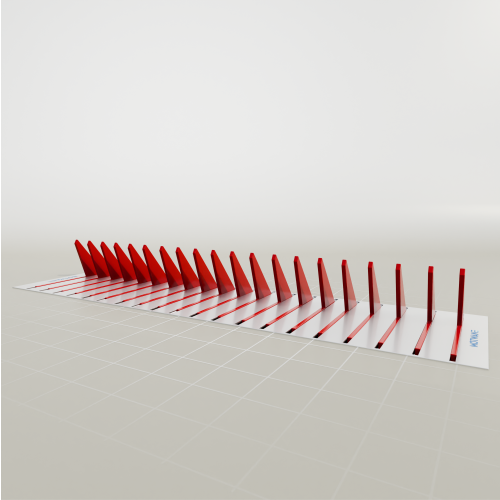FAQs
Frequently Asked Questions
A road spike barrier is a physical vehicle control system designed to prevent unauthorized or forced vehicle entry. It consists of sharp, high-strength metal spikes that rise from the ground when triggered. If a vehicle attempts to pass without proper authorization, the spikes puncture its tires, immediately disabling it. These barriers can be manually operated or automated and are often used in environments where vehicle access must be strictly controlled. The system is an effective deterrent, making it nearly impossible for vehicles to breach entry points without severe damage.
Road spike barriers are typically installed in locations that require strict access control and high levels of security. This includes military bases, border control zones, airports, data centers, government buildings, private industrial estates, and high-security parking areas. They are often positioned at main entry and exit points where the risk of unauthorized vehicle access is high. These barriers ensure that only permitted vehicles can pass while acting as a defensive layer against ramming or forced-entry attempts. Their placement is strategic—complementing other security elements like boom barriers, bollards, or surveillance systems.
Yes, modern road spike barriers are engineered to function effectively even in high-traffic environments. Designed with quick-acting mechanical or hydraulic systems, they allow authorized vehicles to pass seamlessly while being ready to engage instantly when a threat is detected. Many models offer features such as automatic retraction, LED indicators, and synchronization with access control systems, enabling a smooth flow of vehicles without compromising on security. Durable materials and anti-corrosion coatings ensure long-term reliability, even under frequent use and harsh weather conditions.
Absolutely. A road spike barrier can be seamlessly integrated into a larger security ecosystem for enhanced effectiveness. It can work in coordination with RFID card readers, number plate recognition systems (ANPR), biometric access controls, boom barriers, and surveillance cameras. Integration allows centralized monitoring and remote operation from a control room, giving security personnel complete visibility and control over vehicle access points. This layered security approach ensures that access decisions are precise, traceable, and enforceable, making the environment significantly more secure.
Hydraulic tyre killers
are commonly installed at high-risk or restricted access points where vehicular security is a top priority. These include military bases, government complexes, embassies, airport perimeters, industrial zones, oil refineries, and power plants. They are usually placed at entry or exit gates alongside other security systems like boom barriers or bollards. Their primary function is to act as a last line of defense against ramming or forced vehicle entries, ensuring no unauthorized vehicle can breach the protected perimeter.
The hydraulic tyre killer offers several advantages for high-security applications:
- High impact resistance: Built to stop even heavy-duty vehicles attempting forced entry.
- Smooth and fast operation: The hydraulic mechanism allows rapid deployment and reliable performance.
- Long service life: Constructed using reinforced steel and anti-corrosive materials to withstand extreme weather and heavy usage.
- Integration-ready: Can be easily integrated with access control systems, surveillance, and alarms.
- Fail-safe features: Includes manual override and safety sensors to prevent accidental activation on authorized vehicles.
Yes, a hydraulic tyre killer can be seamlessly integrated with various access control technologies such as RFID readers, license plate recognition (ANPR), biometric scanners, and security management systems. This integration allows automated or remote activation based on real-time access permissions. It enhances overall site security by ensuring that only verified vehicles are allowed entry, while any breach attempt results in immediate immobilization. Integration also supports event logging and alarm triggering, offering complete control and traceability at high-security checkpoints.












